This page is still under construction.
Creativity Studies
DCP researchers have been studying killer whales since about 2017, when we began a collaboration with Marineland Côte d’Azur and SeaWorld Texas for our investigation into how killer whales might be creative. Our studies of killer whales followed closely on what we’d done with the dolphins at RIMS with Teri Bolton (read more on that research here – scroll down a bit). Our results with both bottlenose dolphins and killer whales demonstrated that these individuals create original behaviors in response to an innovative cue from a trainer. For our study of killer whales, we included 9 animals, both females and males aged from 5 to 29 years at the time of the study. We found that killer whales produced many behaviors that differed in type and variability. There were a few differences between the sexes with males showing less complex and lower energy behaviors than females; however, this impression might be due to age or size of the animals involved. Still, our results support the notion that killer whales are dynamic and flexible in their thinking and behavior. For those readers who want more details on about the scientific details for our killer whale creativity research, check out our first paper in the special issue of Animal Cognition (Manitzas Hill et al., 2022; see DCP’s publications page for the full citation). Check out the DCP Video on our RIMS dolphin creativity research here or on the Current Projects page.
Activity Budgets
In 2022, DCP began our second, ongoing collaboration with SeaWorld focusing on the killer whales in San Diego. From almost 300 hours of surface video, we investigated the daily activity patterns of the killer whales resident to the SeaWorld California (SWC) facility, finding more similarity with the activity budgets reported for wild killer whales (read the scientific details from this link: Manitzas Hill et al., 2025). We found few differences between the sexes within each behavioral category across the year-long period of study, though individual variability was confirmed for all behavioral categories. All killer whales actively engaged with other group members and their environment in more than a third of our observations. These findings are similar in degree to that observed in various other dolphin populations, which supports the interpretation that this killer whale group is in receipt of positive welfare and displays normal levels of social and individual behaviors for this species. Our results and continuing research add to the growing body of knowledge about how killer whales manage their actions, both with other killer whales and in their environment, as well as across different social settings given their surroundings.
Social Behavior – Individual Interactions and Behavior Exchanges
Our more recent research of killer whale behavior and interactions follows more closely to our more than three decades of work studying smaller dolphins – i.e., our perspective and focus is now underwater but continues to be linked to the surface for a more comprehensive view and understanding of how these large dolphins behave with each other. We continue our studies of the SeaWorld California killer whales with underwater and surface views with comparison to our 30+-year archive of bottlenose and spotted dolphin behavior and interactions – using the same methods to analyze all video data to better understand inter-animal interactions.
In 2025, we also began a collaboration with Loro Parque Fundación (LPF) that has the DCP team studying the killer whales resident to Orca Ocean in Loro Parque, Tenerife, Canary Islands. From both surface and underwater video data, similar to our research of the SWC killer whale behavior and DCP’s other long-term studies of bottlenose and spotted dolphins, we conduct all occurrence, focal animal sampling to investigate how both large and small dolphins share information via touch, varying postures and swim positions, object play, and more. Preliminarily, we are finding more similarity than difference in how all dolphins share contact, exchange social behaviors, engage in play (both with objects and each other), and more. Visit the DCP Blog and our social media platforms for regular updates on this and all our research. And we’ll keep you posted when more papers become available for those of you wanting more scientific details. Until then, check out our photo gallery for this research and analyses (pet approved, of course) below.
In situ and Ex situ Comparisons – All Dolphins DCP Studies
The research methods used by many of the DCP researchers focuses on understanding dolphin behavior and communication at the individual or dyadic level – observing how dolphins share information between individuals from the underwater perspective. For the small dolphins (bottlenose and spotted dolphins), we collect data while swimming among them as non-invasively as possible (i.e., no chasing, no touching, no feeding, etc.). For the larger dolphins, we use aerial imagery (surface mounted cameras at facilities or drone footage for wild animals) and stationary underwater cameras (pool or boat mounted) and occasionally hand-held cameras from colleagues observing wild killer whales in really cold water (Thank you!). Using the same analysis protocols and tools lets us make direct comparisons of all video data that informs our understanding of the social dynamics, societies, and behavioral exchanges among individuals for all the dolphin groups we study. Thank you to Wild Encounters (Debbie & Johnny!) for sharing your video of wild killer whales in Norway for our comparative studies … looking forward to our collaboration!
Research and Data Analyses Photo Gallery
 |
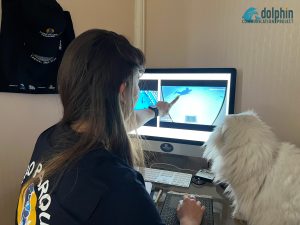 |
While DCP does not study the behavior of our canine/feline family members, we wonder which is more fascinated by these killer whales’ behaviors. Maybe Baloo is more focused on Hazel! |
 |
 |
Manon’s cat, Inouk, seems to want to direct her analyses of the killer whales … or maybe he’s trying to direct them?! |
 |
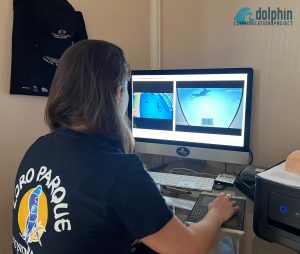 |
We were excited to get our first video exports to begin our studies of the Loro Parque killer whale social interactions and behavior. Coding and analyzing the video opens a window into killer whale behavior; it’s where we first observe the patterns in behavior and interaction! |
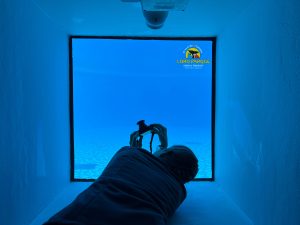 |
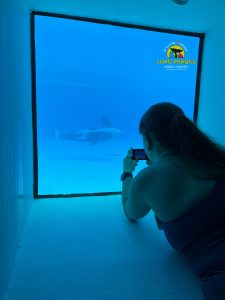 |
Making observations: Kathleen (L) and Manon (R) watching Loro Parque killer whales through the underwater viewing windows. |
 |
 |
(L) Adán playing in the bubble jet and letting the bubbles surround him. (R) Adán and Tekoa seem to take turns sharing the “bubble bath” while playing around each other and with the bubbles. |
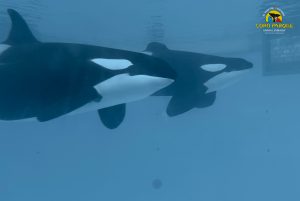 |
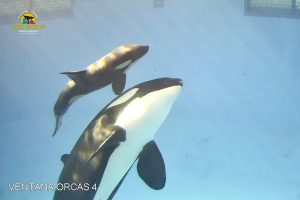 |
(L) Morgan and Tekoa in a slightly staggered parallel pair swim as we observe their slow swim and social interaction. (R) Morgan with her young male calf, born at the end of March 2025!! Morgan shows expected maternal behavior, and the calf is nursing well. Kathleen was thrilled to see their pec fin contacts while Manon focused on their pair swims. |
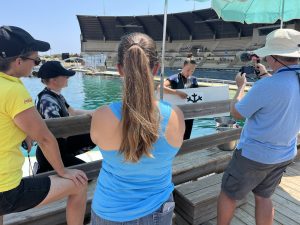 |
 |
Our creativity study of the Marineland killer whales led us to our reading study (both 3D and 2D symbols). DCP (Kathleen, John & Manon) visited Antibes in July 2024, to film and interview the trainers and Wikie and Keijo for our short, informative video about the reading study. Find our creativity paper on the DCP publications page and the Creativity video on the Current Projects page. |
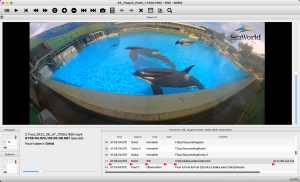 |
 |
(L) BORIS is a useful tool to allow consistency in data coding between researchers. We use it regularly with all our behavior analyses and coding. (R) DCPs confirmation of Group Swims and Duo Swims as well as inter-animal interactions is part of our examination into killer whale social behavior, which seems very similar not only to wild killer whales but also to smaller dolphin species, too. |
 |
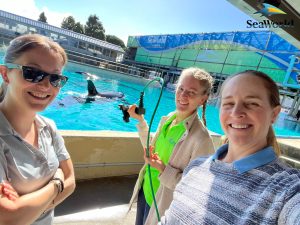 |
DCP is well represented (and stylish in our neon/MVA green polos) as we conduct observations of the SWC killer whales. |
 |
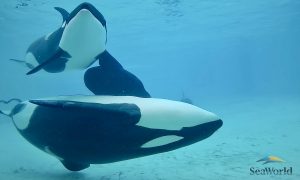 |
We’ve now confirmed that SWC killer whales use pectoral fin contacts much the same as do bottlenose and Atlantic spotted dolphins. |
Research Collaborators into DCP’s Killer Whale Studies



